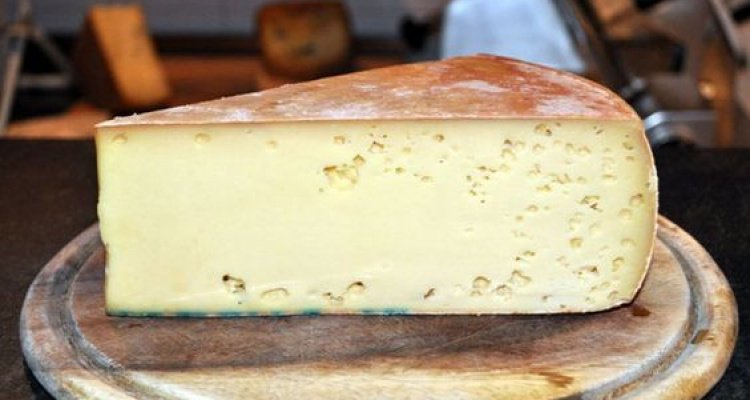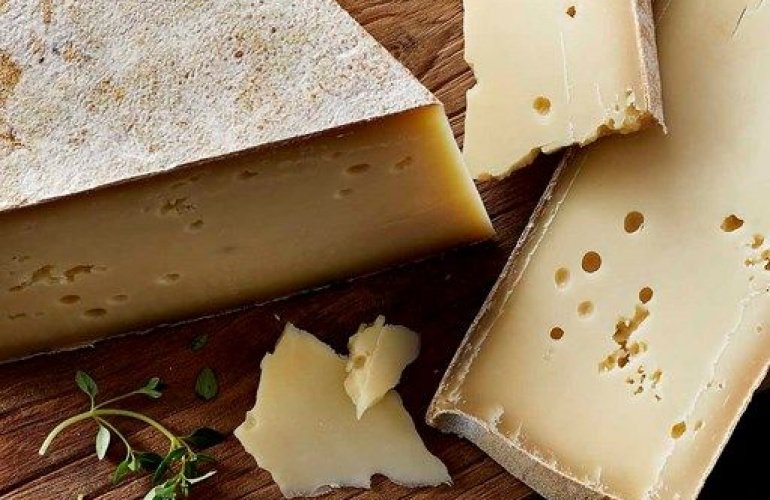What is Fontina? An In-depth Guide to Valle d’Aosta’s Culinary Pride

Today, we’re going to explore one of Valle d’Aosta’s most beloved treasures – Fontina cheese. Known for its rich, creamy texture and nutty flavor, Fontina is a staple in Italian cuisine, but its allure reaches far beyond the borders of its homeland.
In this in-depth guide, we’ll delve into the fascinating world of Fontina, from its humble beginnings on the Alpine pastures to its role in gourmet kitchens around the globe.
So, whether you’re a devoted foodie, a cheese enthusiast, or just someone looking to expand your culinary horizons, sit back, relax, and let’s discover together the unique charm of Fontina – the culinary pride of Valle d’Aosta.
Quick facts about Fontina
| Fact | Description |
|---|---|
| Origin | Aosta Valley, Italy |
| Milk Source | Cow’s milk |
| Texture | Semi-soft |
| Flavor | Mild, nutty, with a hint of sweetness |
| Color | Pale yellow with a dark orange-brown rind |
| Aging Process | Typically aged for around 3 months |
| Melting Quality | Melts well, often used in fondue, pizza, and pasta dishes |
| Varieties | Italian Fontina, Swedish Fontina, Danish Fontina, American Fontina |
What is Fontina?
Fontina is a type of cheese that originates from the Aosta Valley in Italy. It’s a cow’s milk cheese known for its creamy texture and mild, nutty flavor with a hint of sweetness. Fontina is a semi-soft cheese that melts well, making it a popular choice for dishes like fondue, pizza, and pasta.
The cheese is traditionally made in the summer months when the cows are grazing on high alpine grass, which contributes to its unique flavor. The aging process can vary, but it’s typically aged for around 3 months. The rind of Fontina cheese is usually a dark orange-brown color and the interior is pale yellow.
Italian Fontina should not be confused with “Fontinella”, “Fontal”, and “Fontella” cheeses, despite the similar names. While they have similar melting qualities, their flavors can differ significantly.
What does Fontina cheese taste like?
Fontina cheese is known for its rich, creamy texture and a unique flavor profile. Its taste is usually described as mild but distinct, with a nutty and slightly sweet undertone.
The flavor can become more intense and earthy as the cheese ages.
Fontina is also noted for its smooth and slightly elastic texture when melted, making it perfect for fondues and other dishes where a luxurious melt is desired.
Fontina tasting notes

- Appearance: Fontina cheese has a smooth, pale-yellow interior with tiny holes scattered throughout. The rind is usually thin and brown.
- Texture: It boasts a velvety, creamy texture that’s slightly elastic. The cheese is semi-soft and becomes even softer and gooey when melted.
- Aroma: Fontina carries an earthy and woody aroma, often described as reminiscent of fresh-cut hay and the Alpine pastures where the cows graze.
- Taste: Initially, Fontina offers a mild, slightly sweet flavor. As you continue to savor it, you’ll notice hints of nuttiness and a touch of fruity sweetness.
- Aftertaste: The finish is long and complex, with a lingering nutty sweetness and a hint of earthiness.
- Pairings: Fontina pairs well with a variety of foods and drinks. It goes well with light red wines and crisp white wines, crusty bread, fresh fruits like apples and pears, and cured meats.
- Meltability: Fontina cheese is renowned for its excellent melting qualities, making it a popular choice for dishes like fondue, gratins, and pizza.
Note: the flavors can vary slightly depending on the age of the cheese and the diet of the cows that produced the milk.
What cheese is Fontina similar to?
Fontina cheese is often compared to other semi-soft cheeses with good melting properties. Some of these include:
- Gruyère: This Swiss cheese shares Fontina’s excellent meltability and has a slightly sweet, nutty flavor. However, Gruyère can be a bit firmer and more pungent.
- Emmental: Another Swiss cheese, Emmental has a similar texture to Fontina but with a milder flavor and characteristic large holes.
- Taleggio: An Italian cheese like Fontina, Taleggio is also soft and boasts a fruity tang. However, it has a stronger, more pungent aroma due to its washed rind.
- Provolone: This Italian cheese has a similar texture and meltability to Fontina, but its flavor can range from mild to sharp depending on its aging.
- Havarti: A Danish cheese, Havarti is creamy like Fontina with a mild flavor that can become sharper with aging.
What are the different types of Fontina?
Fontina cheese is traditionally made in Italy’s Aosta Valley, but various versions are now produced in other countries. Here are a few types of Fontina:
- Italian Fontina: Also known as Fontina Val d’Aosta, this is the original Fontina cheese. It has a rich and creamy texture with a slightly nutty and earthy flavor. It’s aged for around three months and has a dark orange-brown rind.
- Swedish Fontina: This type of Fontina has a mild and slightly sweet flavor. It’s often used in cooking because it melts well.
- Danish Fontina: Danish Fontina is a semi-soft cheese with a mild flavor and a pale yellow color. It’s less pungent compared to Italian Fontina and is often used in sandwiches.
- American Fontina: Made in the United States, American Fontina is softer than its European counterparts and has a milder flavor. It’s often used in macaroni and cheese, grilled cheese sandwiches, and other dishes where a good melting cheese is needed.
Remember, each type of Fontina can have slight variations in flavor and texture based on factors like the diet of the cows and the specific aging process used.
Is Fontina cheese like Mozzarella?
Fontina and Mozzarella are both Italian cheeses, but they do have some significant differences.
| Feature | Fontina | Mozzarella |
|---|---|---|
| Origin | Italy (Aosta Valley) | Italy (Campania) |
| Texture | Semi-soft, slightly elastic | Soft to semi-soft, very elastic |
| Flavor | Mild to intense, nutty, slightly sweet | Mild, milky |
| Aging | Can be aged to intensify flavor | Usually consumed fresh |
| Melting | Melts smoothly and evenly | Becomes stretchy and stringy when melted |
| Uses | Fondue, gratins, sauces, sandwiches | Pizza, lasagna, caprese salad |
| Pairings | Light red wines, crisp white wines, crusty bread, fresh fruits, cured meats | Tomatoes, basil, olive oil, light white wines, crusty bread |
| Appearance | Pale-yellow interior with tiny holes, thin brown rind | White, smooth with no rind |
| Aroma | Earthy, woody, reminiscent of Alpine pastures | Slightly tangy, milky |
- Texture: Mozzarella is typically softer than Fontina. Fresh Mozzarella has a high moisture content and a very soft, almost spreadable texture, while Fontina is a semi-soft cheese with a firmer texture.
- Flavor: Mozzarella has a mild, milky flavor, while Fontina has a more complex, nutty and slightly sweet flavor that intensifies with aging.
- Melting: Both cheeses melt well, but they behave differently when heated. Mozzarella becomes stretchy and stringy, making it ideal for pizza and lasagna. Fontina melts smoothly and evenly without becoming stringy, which makes it a good choice for fondues and sauces.
- Aging: Mozzarella is usually consumed fresh, while Fontina can be aged, which deepens its flavor.
While Fontina and Mozzarella share some characteristics, they offer different textures and flavors, making each of them better suited to different culinary uses.
>> Click here to read our in-depth guide on Mozzarella
What is Fontina cheese good for?
Fontina cheese is extremely versatile, making it a favorite in many recipes. Here are some ways it can be used:
- Fondue: Fontina’s smooth melting quality makes it ideal for a rich and creamy fondue.
- Gratin Dishes: It can be used in gratin dishes due to its excellent melting characteristics.
- Sauces: Fontina can be used in sauces for pasta or risotto because it melts evenly and smoothly, adding a rich and creamy texture.
- Sandwiches and Paninis: Its melting ability also makes it perfect for sandwiches or paninis.
- Pizza: While mozzarella is the traditional choice for pizza, Fontina can be a delicious alternative or addition, giving a slightly nutty flavor.
- Quiches and Frittatas: Fontina can be used in quiches or frittatas, where it adds a creamy, rich texture.
- Cheese Boards: With its complex, slightly sweet flavor, Fontina can hold its own on a cheese board, paired with fruits, nuts, and a nice glass of wine.
- Baking: Fontina can be used in baking, especially in dishes like stuffed breads or rolls where a good melting cheese is required.
Is Gruyere the same as Fontina?
Gruyère and Fontina are both European cheeses, they are somewhat similar in terms of meltability and sweetness but they are not the same. They come from different countries, have different flavors and textures, and are used in different ways in cooking.
Here’s a comparison of the two:
| Feature | Gruyère | Fontina |
|---|---|---|
| Origin | Switzerland (Canton of Fribourg) | Italy (Aosta Valley) |
| Texture | Hard, dense and smooth | Semi-soft, slightly elastic |
| Flavor | Nutty, slightly sweet, stronger with aging | Mild to intense, nutty, slightly sweet |
| Aging | Aged for several months to over a year | Can be aged to intensify flavor |
| Melting | Melts well, often used in baking | Melts smoothly and evenly |
| Uses | Fondue, quiches, gratins, sandwiches, cheese boards | Fondue, gratins, sauces, sandwiches, cheese boards |
| Pairings | Crusty bread, charcuterie, pickles, white wines, full-bodied red wines | Light red wines, crisp white wines, crusty bread, fresh fruits, cured meats |
| Appearance | Pale yellow with small holes, brownish rind | Pale-yellow interior with tiny holes, thin brown rind |
| Aroma | Fruity, earthy | Earthy, woody, reminiscent of Alpine pastures |
While both cheeses are great for melting and are often used in similar dishes, their distinct flavors and characteristics make each unique.
>> Click here to read our in-depth guide on Gruyère
Is Fontina a healthy cheese?
Like many cheeses, Fontina can be part of a healthy diet when consumed in moderation. It’s important to consider both its nutritional benefits and drawbacks.
Benefits:
- Protein: Fontina is high in protein, which is essential for building and repairing body tissues.
- Calcium: It’s also a good source of calcium, a mineral that’s vital for bone health.
- Vitamin A: Fontina contains Vitamin A, which supports eye health and immune function.
- Vitamin B12: This cheese provides Vitamin B12, a nutrient that helps keep the body’s nerve and blood cells healthy.
Drawbacks:
- High in Fat: Like many cheeses, Fontina is high in fat, particularly saturated fat, which can contribute to heart disease if eaten in excess.
- High in Sodium: It also tends to be high in sodium, which can contribute to high blood pressure in some people.
- High in Calories: Fontina is calorie-dense, meaning it provides a lot of calories relative to its weight, so it should be eaten in moderation if you’re watching your calorie intake.
Note: it’s best to talk to a healthcare professional or a registered dietitian about how Fontina cheese can fit into your individual diet and health goals.
Fontina nutrition facts
| Nutrient | Amount per 100g | Amount per 1oz (28.35g) |
|---|---|---|
| Calories | 389 kcal | 110 kcal |
| Protein | 25.6g | 7g |
| Total Fat | 31.14g | 8.8g |
| Carbohydrates | 1.55g | 0.4g |
| Sugar | 3.52g | 1g |
10 best Fontina substitutes
| Substitute | Description |
|---|---|
| Havarti | It melts well and has a creamy texture, similar to Fontina. It has a mild, slightly tangy flavor. |
| Gouda | Known for its smooth texture and rich, unique flavor, Gouda is a great melting cheese like Fontina. |
| Provolone | It has a similar texture and melting qualities to Fontina. Its flavor ranges from mild to sharp depending on aging. |
| Emmental | A Swiss cheese that has a slightly sweet, nutty flavor. It melts well, making it a good substitute for Fontina in many dishes. |
| Grana Padano | An Italian cheese with a grainy texture and a complex, nutty flavor. It’s less creamy but can replace Fontina in certain recipes. |
| Mozzarella | Known for its exceptional melting qualities and mild flavor, Mozzarella can be used in place of Fontina in many dishes. |
| Gruyere | It has a smooth melting quality and a nutty, slightly sweet flavor similar to Fontina. Great for baking and fondue. |
| Taleggio | This Italian cheese has a strong aroma but its flavor is comparatively mild, fruity and tangy. Melts well like Fontina. |
| Edam | A Dutch semi-hard cheese with a nutty, slightly sweet flavor and a smooth texture. It melts well, similar to Fontina. |
| Monterey Jack | An American cheese known for its mild flavor and excellent melting qualities, making it a good substitute for Fontina. |
What pairs best with Fontina?
Food that pairs well with Fontina
| Category | Foods that Pair Well with Fontina |
|---|---|
| Fruits | Dried dark fruits like dates, raisins, and figs, fresh fruits |
| Breads | Crusty Italian bread |
| Meats | Cured meats like ham and bacon |
| Others | Black olives, chocolate, pizza dough, artichoke hearts |
| Cuisine | Common in American food and Italian food |
Also read: What Fruit Goes on a Charcuterie Board?
Beverage that pairs well with Fontina
| Category | Beverages that Pair Well with Fontina |
|---|---|
| Red Wines | Cabernet Sauvignon, Syrah, Pinot Noir, Chianti, Barbera, Barolo, Barbaresco, Nebbiolo |
| White Wines | Franciacorta, Chardonnay, Pinot Grigio, Pinot Blanc |
| Sparkling Wines | Champagne Method Sparkling |
| Non-Alcoholic Drinks | Tea, Coffee, Drinking chocolate, Lemonade, Soda, Chicha Morada |
Also read: Best Wine and Cheese Pairings: The Ultimate Guide
The history of Fontina

Fontina cheese originates from Italy, specifically from the Aosta Valley region which is in the Alps. The history of Fontina dates back to around the 12th century, making it one of the world’s oldest cheeses.
The name “Fontina” might have come from the pastureland of Mont Fontin and the ancient village named “Fontinaz”. The cheese was traditionally made from the milk of cows that grazed on the rich, high-altitude pastures of the valley.
Fontina has been produced in the same traditional way for centuries. It is made from unpasteurized cow’s milk, and the cows are often fed only on grass to keep the taste pure. After production, the cheese is aged for a period of three months to several years, which helps develop its unique flavor and texture.
Over the years, Fontina cheese has gained popularity worldwide due to its versatile culinary uses. It is known for its excellent melting properties, making it an ideal choice for dishes like fondue and gratin. Today, while there are many versions of Fontina made in different countries, the original Italian Fontina Val d’Aosta has been granted DOP (Denominazione di Origine Protetta) status, ensuring that only cheese produced in the Aosta Valley using traditional methods can be called Fontina.
Frequently Asked Questions
1. Is Fontina a melting cheese?
Yes, Fontina is considered a superb melting cheese. Its creamy and smooth texture when melted makes it ideal for use in a variety of dishes. Its melting quality is one of the reasons why it’s often used in fondue, as well as in sauces, pasta, and pizza.
When melted, Fontina maintains a mild, slightly sweet flavor that complements many other ingredients well.
2. Is Fontina cheese sweet?
Yes, Fontina cheese has a slightly sweet flavor. It’s described as having a nutty and earthy taste with a hint of sweetness. This flavor can vary somewhat depending on the specific variety of Fontina.
For instance, Italian Fontina tends to have a sharper flavor, while Swedish and Danish versions are lighter and slightly sweeter. The sweetness of Fontina cheese makes it a versatile ingredient that pairs well with a variety of foods and beverages.
3. How to pronounce Fontina?
Fontina is pronounced as “Fon-TEE-nuh”. The emphasis falls on the second syllable, “TEE”. Remember, the pronunciation can slightly vary in different regions and languages.
Also read:
- Menonita Cheese: A Staple in Northern Mexican Cuisine
- All About Swiss Cheese: A Comprehensive Guide
- The Ultimate Guide to Bocconcini: From Origin to Plate
- The Ultimate Guide to Muenster Cheese: Savor the Flavor
- The Ultimate Guide to Hoop Cheese: A Southern Delight
- The Ultimate Guide to Chèvre: Exploring Goat Cheese
- The Ultimate Guide to Kasseri: A Taste of Tradition





